After checking into the Oro Verde Hotel, I asked for a map of the city center and recommendations for things to do in Guayaquil, Ecuador. The concierge hesitated for a moment before unfolding one on the countertop. He marked off the sites of interest: museums; the Malecon 2000, a broad boulevard dotted with gardens, restaurants, playgrounds and theaters that runs for miles along the Guayas River; and the 444 steps of Santa Ana Hill that lead to a lighthouse and chapel at the top. “Please allow us to arrange for one of our taxis when you are ready to go,” he finished. When I explained that I preferred to walk he grew concerned. “Then you must stay on the main street, El Neuve de Octubre, that runs past the hotel,” he insisted. “And you must not go out alone at night.”
The next morning I walked briskly past the two black-suited, stone-faced, earbud-wearing security guards in the hotel lobby and onto the main street. Alert to possible danger, I was immediately aware of a massive police presence; in the three blocks between the hotel and a cellular phone store I counted 18 police officers, many wearing bulletproof vests, while private security guards manned the entrances of banks and retail stores. Minutes later, armed with an Ecuadoran phone number for my iPhone, I extracted my camera from my backpack and continued toward the Malecon 2000. Before I’d gone a block I was flagged down by a policeman who politely suggested that I stow my camera. “I’m a photographer and it’s my job to take photos,” I patiently explained. He was somewhat mollified when he learned I had a local phone. “If anything happens, you must dial 101. It’s the emergency number here in Guayaquil.”
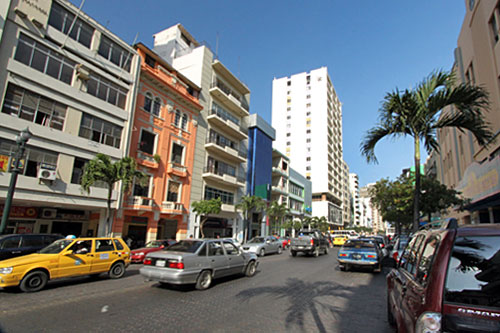
All around me businessmen walked to their offices, customers streamed in and out of retail stores and mothers pushed infants in strollers. The city didn’t feel dangerous to me. Mystified, I stopped several different officers and security guards along the way, asking the same question of each, “Is it safe for me to walk here alone?”
Guayaquil, the largest city in Ecuador, is also reputed to be the most dangerous and violent city in the country. Because it is the economic engine for the nation, Guayaquil has attracted a large number of immigrants from surrounding countries, as well as poor, rural Ecuadorians who have flocked to the city in search of opportunity. The Internet is rife with reports of assaults, robberies, rapes and kidnappings and both the U.S. State Department and U.K. Foreign and Commonwealth Office contain strongly worded notices about the dangers of Guayaquil. Lonely Planet’s Thorn Tree Forum contains scores of stories from visitors who have been robbed and/or assaulted. Generally, these warnings do not alarm me; I have visited dozens of supposedly unsafe cities around the world and discovered the dangers are almost always exaggerated. However, the unprecedented police presence in Guayaquil gave me pause.
Interestingly, the officers I queried were in disagreement. Some asserted that I would be perfectly safe in the well-patrolled tourist areas, while others insisted I should not walk alone anywhere in Guayaquil. Since that was not an option, I redoubled my usual watchfulness and set out to check off my list of things to do in Guayaquil. The Malecon 2000 is well-lit and filled with locals who patronize the restaurants, attend concerts, and bring their children to play in the extensive playgrounds after work each evening. I spent a good deal of time there and never once felt unsafe walking along the river, not even after dark.
Later that afternoon I stopped by Parque del Centenario to watch the iguanas begging water and ice cream from families seated on park benches. Across the plaza, crews were setting up a sound system for a performance of the Banda Blanca de la Armada de Equator, the Navy Band of Ecuador. By chance, I had arrived during the 10-day celebration of the Independence of Guayaquil. The first city to cast off the shackles of Spain’s domination, Guayaquil’s resistance set in motion revolutions all over the country and is considered to be the roots of Ecuador’s independence. The orchestra struck up a number and I joined the crowd, watching with amusement as a young boy and a slightly inebriated Guayaquileno lip-synched to the patriotic number belted out by the band’s vocalist. Viva Guayaquil! echoed across the square at the end of each number. I joined el grito – the scream – that resounded throughout the country during the struggle for independence. Viva Guayaquil!
Can’t view the above slideshow of things to do in Guayaquil, Ecuador? Click here.
One day I opted to explore Santa Ana hill, a neighborhood at the end of the Malecon 2000 where vibrantly painted casitas sprout from the slopes of like bunches of Dutch tulips. One block beyond the staircase leading up Santa Ana hill I spotted a lovely old church with a rose-colored facade. Flagging down a nearby security guard, I inquired if it was safe to visit the church. After a moment’s consideration he said yes, but advised me to watch my belongings. Unmolested, I took a few shots of the church’s exterior but upon stepping inside I was followed by a middle-aged woman who attempted to strike up a conversation. No hello, how are you; no niceties. The only thing she wanted to know was how much my camera cost. I pretended I didn’t speak Spanish and reported her to the security guard outside, who promptly told me I should not be in that neighborhood. Moments later, a man in white shirt and tie came out of a nearby office building and escorted me back to the Santa Ana stairway, explaining that city employees keep an eye on tourists because they want everyone to have a good experience in their city.
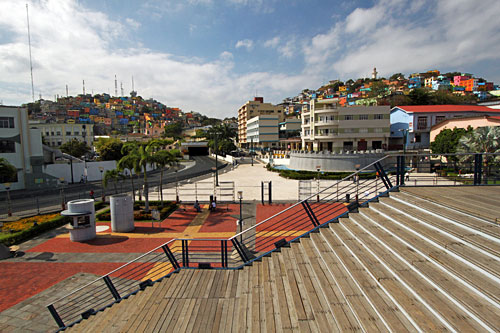
Back at Santa Ana hill I began the long trudge via winding stone staircases. Maps along the way showed several routes to the top but security guards not only insisted I stay on the steps that were numbered, they followed me all the way, using their walkie-talkies to hand me off from one guard to the next. Later, on the way down, I was allowed to go down one side street that was heavily guarded, but when I tried to turn down Calle de las Animas (Spirit Street), a resident poked his head out the window of his house and warned me to turn back – “peligroso alla,” he insisted, dangerous there.
After being in the city for five days I was more confused than ever. I couldn’t reconcile the unfailingly polite and gracious people I was meeting with police officers whose expressions screamed, “What are you doing here, crazy lady?” On my final day I took a last stroll along the Malecon and noticed a series of large photos on display in an area I hadn’t previously visited. They memorialized the events of September 30, 2010, when Ecuadorian police revolted against a proposed new law they believed would reduce their benefits.
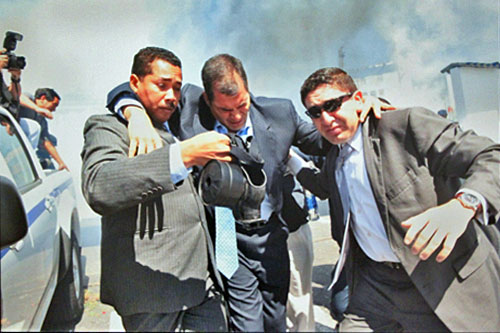
Simultaneously in at least three major cities, officers withdrew from their posts, blockaded roads with burning tires, and seized police buildings. With no police presence, lawlessness ensued. Rocks shattered glass plate windows in Guayaquil’s city center and buildings were burned in the suburbs. In Quito, President Rafael Correa appeared at police headquarters to demand an end to the revolt and was attacked with tear gas. Security guards hustled the President away to the hospital, which was promptly surrounded by police. In response thousands of civilians, mostly blue collar workers, gathered around the hospital in a show of support for Correa, demanding his release. Ten hours later military forces that had remained faithful to the government rescued Correa, but not before four people were killed and 193 wounded. Later, police radio recordings from the night of September 30th revealed that police intended to kill the President
Can’t view the above slideshow about the Ecuadorian uprising of September 30, 2010? Click here.
I learned about the events of September 30th at the Museum of Archeology and Contemporary Art and later read up on the political history of Ecuador. Between 1997 and 2007, the country had eight presidents, two of whom were overthrown in coups. One of those who was overthrown, Lucio Gutiérrez, was witnessed directing the protests in Quito and there is speculation that he masterminded the well-coordinated revolt, using misinformation about the proposed law to stir up sentiments among law enforcement personnel. Fortunately, the demonstrations were short-lived; police went back to work the next day and Guayaquil was back to normal. After an investigation a general amnesty was declared and five days after the event the government decreed a salary increase for the police and the armed forces. But given the dichotomy between the warm and welcoming attitudes of Guayaquilenos and the impassive, callous demeanor of some of the police officers, I can’t help but wonder if the common people’s support of Correa during the events of September 30th is a wound that still festers.
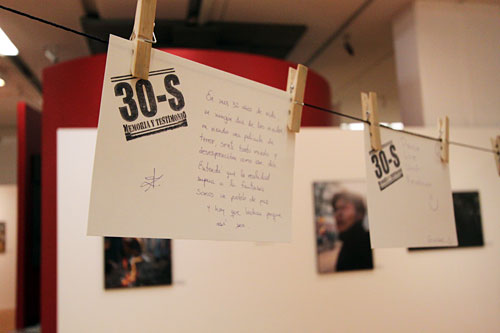
The museum exhibits that memorialize the September 30th uprising are a testament of the depth to which the populace was affected by the event. In one room, tear gas canisters are scattered around a circular pile of dried, paper-thin flower petals. Hand-written index cards clipped to clotheslines strung above the highly polished floor tear at the heart. One says, “In my 32 years of life, I have never felt as much fear and desperation as I did on that day; it was like watching a horror movie. Truth is stranger than fantasy. We are a people of peace and yet we fight.” A second declares, “Enough of Beasts – long live the Democracy.” A third, simply, “Peace, Ecuador.”
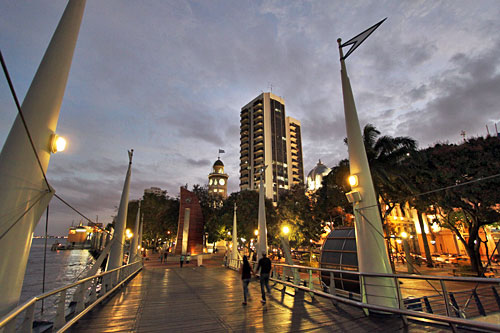
Guayaquil is just beginning to emerge from its history as a rough and tumble port city with not much of a tourism infrastructure. But as I strolled the renovated Malecon, only just completed in 2000, the pleasure of residents who flock to the waterfront each evening was palpable. Perhaps in time that attitude will spill over to law enforcement and replace their paranoia with civic pride. In the meantime, visitors who take normal precautions like not flashing money around or wearing a lot of jewelry, and who stay strictly inside the designated tourist zones, will find that there are plenty of interesting things to do in Guayaquil.
Where to stay in Guyaaquil:
I stayed at both the upscale Oro Verde Hotel, located in the center of the business district, and the economical Manso Boutique Hostal, located directly across the street from the Malecon, where I paid $10 per night in a four-bed dorm with ensuite bathroom. A bonus for me, Manso offered vegetarian breakfasts and lunches for $3 each.
Photos of the 2010 revolt displayed in the second slide show are provided courtesy of the Museum of Archeology and Contemporary Art in Guayaquil

Very interesting commentary and photos.
FWIW – I lived in Guayaquil from 1973 to 1986. I arrived with basically no money, and stayed to start a business which eventually became successful enough to sell. This was before all the development of all the tourist attractions you mention. It was a mixed bag. A wide variety of people. Many very nice and very upstanding people. Also a fair number of thieves, scammers, muggers, etc. In general, a very, very rough place. Seems better now – at least from tourist point of view.
Hi Robert: I think it’s still pretty rough, but within the protected tourist area it is well patrolled and pretty safe.
I lived in Guayaquil for a couple years in the late 1990s. It is generally a safe city. But like any large city in the world, there are both safe parts of town as well as dangerous neighborhoods. Most of the people are very good. Even the one time when I encountered a thief, I did not feel any danger and was never hurt. Never carry a lot of money, don’t be flashy. You will be fine.
Thanks Chris. Appreciate your input.
I agree with you
I am also a citizen of Guayaquil.
It is safe for you depending of hour and area. I was a tourist guide for some of my Japanese friends and everything was okay.
We had a great time and they felt happy.
Awesome article, thanks for the tips! Indeed, Ecuador has a great mix of different sceneries and attractions such as the peerless Galapagos Islands, awe-inspiring Inca monuments, colonial architecture, acres of unspoilt rainforest and many more.
However, there are tourist-targeting scammers and petty crime to be wary of.
Do be wary of the Ayahuasca scams, spilling scam, gate ticket not bus ticket scam, unofficial taxi express kidnappings, sob story scam, Fake currency and many more!
Good tips, David. Thanks.
Thank you for this post and your thoughtful descriptions of Guayaquil. We’ve been to Guayaquil 4 times now from 2014 – 2016. We’ll be back in 2018. I agree hat for the solo traveler, Cerro del Carmen is less safe than Cerro Sant’ana; we were fortunate to meet a family from Cerro del Carmen who’ve guided us through the streets there. We’ve felt safe walking from there to the Cementerio General, on the street that takes you through to the cemetery the back way.
Because we met people who teach at UARTES, and before that at the technical college for visual, theater, and sound arts, we were directed to a small hotel a few blocks off the Malecon, and about 5 blocks north of 9 Octubre. It’s basic but functional. We’ve walked every day from there up to Las Penas, and down to the park of the Iguanas.
The University of the Arts (UARTES) is right next to the Manso Boutique Hotel-we’ve not stayed there, but we have had great almuerzos.
I agree that there are areas not safe to just walk through blindly, but I grew up in Chicago, live near Detroit, and I feel the same about them.
Finally, Barbara, what got us going on our first return trip there was an invitation for my wife to teach a workshop in alternative photographic processes. We made a lot of friends in the community of artists there—including a couple who live near the top of Cerro del Carmen.
Hi Jay: Thanks so much for your input. I had read that in recent years, the municipality had done much more to make the city center safer, so I was really glad to read your account.
thanks very much Barbara for writing this – you seem very sensible and i really appreciate your insights
You’re very welcome, Marijke.
Hello,
Any precaution as far as a healthwise. We are going to Guayaquil for a tennis tournament next week. Thank you
En route to Galapagos , I will be stopping at Guayaquil. I am traveling alone and love to take photos with my dslr camera. I realized it’s a no no after reading all the above comments. May I know what camera you used? – Tim
I used my DSLR. I packed it away in y messenger bag and only brought it out when I wanted to take a photo. But I was told several times by police not to wander outside of the tourist areas, which are all heavily patrolled by police, and I suspect that is still good advice.
Hello for anyone wanting a nice hotel to stay in, check out the hotel Valeria man-ging! It is great! Cheaper than oro Verde across the street !
Hello Everyone.
I am planning to go to Ecuador (guayaquil) next week on 7th November.
Can I get in touch with some local for advice?
Best regards
Syed from Netherlands
Sorry Sayed, but I have no local contacts.
Hi Barbara;
First I would like to say thank you so much for writing this article about Guayaquil, the City that I was born. I really enjoy reading the good advice you give to others in reference to visit Guayaquil.
As you say Guayaquil is very safe in the tourist areas, as in any other big city in the world, there are areas were very poor people lived and unfortunately rob and take away people items to survived the easy way.
Most people from Guayaquil are very caring and nice people, but certainly I will consider to walk by the dangerous places and even worst carry expensive articles with me.
Guayaquil welcome all tourists to our city, and I will definitely recommend to always ask the police people to guide you were and were not to go when visiting the city.
Once again, thank you so much for this beautiful article and I hope you visit again as there are many other tourist secure places you can go while in Guayaquil.
I hope you got to enjoyed the delicious dishes Ecuador have to offer as well!!!
Hi Jazmin: You’re very welcome.I totally enjoyed my time in Guayaquil. But had to also say that the food of Ecuador was so good that I devoted an entire post to it!
1st of all, must say I love Ecuador, in fact I bought property there hoping to retire there at some point.
Regarding the heavy police presense, this can be both good and bad. I have had to bribe a cop to keep out of jail, when he wrongly stated that the insurance on my rental car was expired. Either pay the bribe ($60) or miss my flight home and leave my wife abandoned downtown.
My nephew and his girlfriend were pulled off a bus leaving Salinas, and were forced to hand over their money to the police, or face being hauled off. Very ugly scene! He’s 6 foot 4, so that made the police a little leery and they had guns pointed at them.
On the other hand, I’ve had many pleasant experiences with the police there, even had one hand me his assault rifle (which was fully loaded) while he withdrew some money from the ATM. They certainly seem to trust us lowly Canadians 🙂
Barbara,
Thank you for this post. I am heading back to the Galapagos in a few months, and have been given a 15 hour layover from my airline, so I will likely be stepping out of the airport. I’ve actually been to Quito before, but never Guayaquil, and was also told how dangerous Quito was but never felt unsafe when I stuck to the well trodden tourist paths. I’m generally not worried about pickpockets (because I take precautions) but I was worried about Guayaquil’s reputation for muggings– thanks for allaying many of my concerns. Looking forwards to spending some time in the beautiful city, hopefully the police will have changed their attitudes somewhat– here’s to hoping!
You’re welcome, Sophia. As in Quito, I think you’ll be just fine if you stick to the tourist areas in Guayaquil, where police presence is heavy.
Thank you for this article, which was very informative. I am in Guayaquil at the moment, and on Sunday I too decided to venture along the Malecon and then climb the steps on Santa Ana hill. Once my stroll along the malecon was finished, I found myself at the bottom of a staircase leading up Santa Ana hill.
I’m not sure this was the infamous 445 step staircase (I suspect not), but it was a step stairway up and was leading me to the top. It looked safe enough and I certainly felt secure as a 42 year old male that has traveled in about 60 countries.
I got about halfway up and then the stairway banked left but for some reason, I decided to go right. There again didn’t feel any reason to be concerned, as literally there was noone around. I walked aways and was generally headed in an upward direction and figured it would lead me eventually to the top. Little did I know that I was not in a safe place at all. I rounded a corner and immediately there was a group of about 8 males around 18-20 years of age. I had no choice but to not make eye contact and continue on my way.
It all happened so extremely fast. In an instant they were on me, all pinning me down and with surgical precision went about quickly going through my pockets. I resisted and let out an audible yelp. Not a good idea. The one above me had his fist in the air and threatened to pound me. I dutifully shut up. As quick as it started it was over. I was spat out onto the concrete with my hotel key and credit card on the ground (interestingly, they didn’t take that….). They did however relieve me of my cell phone, about 60 USD and my watch.
The residents in the area thankfully came to my aid and accompanied me to a security guard who called the police. They were so compassionate, and gave me water and hugs. At the same time, they chastized the police for the lack of signage for tourists to let them know to stay out of the area.
That was my experience, which as you can imagine was not a good one. Fortunately I wasn’t physically harmed and recognize it could have been way worse. So let this be a warning to anyone contemplating visiting the area.
Rob
Hi Rob, and thanks for your long and very detailed description of what happened to you in Guayaquil. I was told in no uncertain terms while walking up Santa Ana Hill, to only take the marked route, as branching off could be dangerous. I did sort of lose my way at one point and wandered off in the wrong direction, and a woman poked her head out of an upstairs window and told me to go back, as that way was dangerous. It definitely could be better marked, and I hope that the city takes such measures soon, as it really is a lovely city and it would be a shame if tourists stopped going there.
Rob, as an Ecuadorean I apologize for the bad moment you had to experience while visiting the city. I’m glad there were others that help you recover from that horrible experience